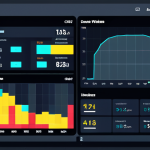I remember vividly the thrill of seeing my first “Hello, World!” app come to life, fresh out of a coding bootcamp. The textbooks made everything seem so neat, so logical, a straightforward path from problem to elegant solution.
Then came my first actual job, and suddenly, that pristine theoretical knowledge felt like a tiny island in a vast, chaotic ocean. It’s a moment every aspiring web developer eventually faces: the jarring, often humbling, realization that the real world of development operates on a completely different set of rules than what you learned in a controlled environment.
You might be fluent in React’s component lifecycle or deeply understand database normalization, but then you’re thrown into a sprawling legacy codebase built with obscure frameworks, grappling with an API that barely works, or debugging a performance issue on a mobile device in a remote village with spotty internet.
The curriculum never prepares you for the endless iterations of client feedback, the brutal deadlines, or the delicate art of managing technical debt that accumulates faster than you can pay it down.
In today’s rapidly evolving tech landscape, where concepts like serverless functions, edge computing, and AI-driven development tools are becoming mainstream almost overnight, simply knowing the syntax isn’t enough.
You quickly learn that true expertise isn’t about memorizing every library; it’s about resilient problem-solving, continuous adaptation, and the uncanny ability to learn on the fly.
It’s a journey filled with exhilarating breakthroughs and humbling roadblocks, but one that fundamentally shapes a truly capable developer. Ready to uncover the stark realities and thrilling nuances that separate textbook knowledge from battlefield expertise?
Let’s dive into the nitty-gritty and truly understand this journey.
The Unruly Beast: Navigating Legacy Code

I remember vividly my first encounter with a truly colossal, decades-old codebase. Fresh out of bootcamp, my mind was organized around clean, modular components, perfectly named variables, and pristine design patterns.
Then, I was thrown into a project with files dating back to the early 2000s, where functions were hundreds of lines long, variables were named , and the documentation consisted of a single, cryptic Post-it note on a long-gone developer’s monitor.
The textbook preached elegant architecture; reality screamed “survival of the fittest.” This wasn’t about building from scratch; it was about understanding, adapting, and painstakingly patching a living, breathing digital organism that had evolved through countless hands, hurried deadlines, and forgotten best practices.
You quickly learn that half your job isn’t writing new code, but deciphering the past, understanding why certain “quirks” exist, and figuring out how to introduce a new feature without toppling a delicate house of cards built on years of expediency.
It’s a humbling experience, forcing you to develop a sort of digital archaeology skill, tracing data flows through labyrinthine functions and praying you don’t break something in a module nobody touches anymore.
This journey profoundly shifts your perspective from being a code builder to becoming a code steward, recognizing that every line you write contributes to the next generation’s legacy burden.
1. The Art of Code Archaeology
When you first start, you’re taught to write, write, write. But in the real world, especially with established companies, you spend an enormous amount of time reading and understanding code that wasn’t written by you, often by people who have long since left the company.
I once spent an entire week trying to trace a single data point through a multi-layered application, only to find the root cause of a bug in a forgotten configuration file buried deep within a deployment script from 2010.
This isn’t just about syntax; it’s about understanding the historical context, the business rules that changed over time, and the previous compromises made.
It’s like being a detective, piecing together clues from old commit messages, forgotten comments, and often, the sheer absence of any explanation. You become adept at inferring intent from obscure function names and variable declarations, developing a sixth sense for where the hidden pitfalls might lie.
This deep dive into the past helps you appreciate the true cost of “quick fixes” and the long-term impact of technical debt, fostering a more responsible approach to your own coding practices.
2. Adapting to Unconventional Patterns
Textbooks often present a streamlined, best-practice approach to design patterns and architectural styles. In the wild, however, you’re constantly encountering patterns that are, shall we say, “unique.” I’ve worked on systems where critical business logic was embedded directly into HTML templates, or where database queries were constructed dynamically from concatenated strings of user input, creating a terrifying landscape of potential vulnerabilities and maintenance nightmares.
The challenge isn’t to re-architect everything overnight – often that’s simply not feasible – but to find the most pragmatic path forward. This means learning how to work within existing constraints, identifying the most critical areas for refactoring, and incrementally improving the codebase without breaking the existing, often fragile, functionality.
It forces you to be pragmatic, prioritizing stability and gradual improvement over a complete, theoretical overhaul. It’s about finding the balance between idealism and the immediate needs of a live product, which is a skill no amount of theoretical reading can fully teach.
Debugging: A Masterclass in Patience and Problem Solving
Debugging. Ah, debugging. The unglamorous, yet utterly essential, backbone of web development.
In a university setting, bugs are typically clear, isolated, and often directly related to the concept you’re currently studying. You make a syntax error, the compiler tells you exactly where.
You write an incorrect algorithm, the test case fails predictably. In the real world, bugs are elusive, interconnected, and often manifest in ways that defy logic, popping up randomly for a small subset of users in a particular timezone using an outdated browser on a slow connection.
My most memorable debugging nightmare involved an intermittent issue that only occurred on mobile devices, on a specific cellular network, and only when the user was also connected to Bluetooth headphones – a truly bizarre constellation of factors that took days to unravel.
It’s not just about finding the error in your code; it’s about understanding the entire ecosystem your application lives in, from network latency and server load to third-party API quirks and browser inconsistencies.
This isn’t just about technical skill; it’s a test of mental fortitude, an exercise in logical deduction, and a deep dive into the unpredictable nature of distributed systems.
1. The Elusive Nature of Intermittent Issues
When you’re first learning, most bugs are reproducible. You change something, it breaks, you fix it. Easy.
But then you get into the wild, and you hear phrases like “it happens sometimes,” or “it only happens for John from accounting on Tuesday afternoons.” These are the ghosts in the machine, the intermittent bugs that defy easy replication.
I once spent two sleepless nights trying to track down a payment processing error that would only occur if a user’s session token expired mid-transaction while they were simultaneously refreshing the page.
These are the bugs that demand a systematic approach, meticulous logging, and often, a deep understanding of asynchronous operations and race conditions.
You learn to embrace the scientific method: formulate a hypothesis, design an experiment (often a very specific sequence of user actions or environmental conditions), and observe the results.
It’s a testament to patience, resilience, and the sheer joy of finally pinning down a phantom problem that has plagued users for weeks.
2. Beyond the Stack Trace: System-Wide Diagnostics
The stack trace is your best friend in controlled environments. It points you to the line, the function, the module. But what happens when the problem isn’t in your code, but in the database server configuration, a misconfigured load balancer, or a dependency issue with a third-party service you barely understand?
I recall a production outage that turned out to be caused by a minor change in a CDN configuration that indirectly affected how a specific asset was loaded on older browsers, leading to a cascade of UI failures.
This taught me that debugging isn’t just about code; it’s about system-wide diagnostics. You need to understand how to read server logs, analyze network traffic (using tools like Wireshark or browser developer tools), interpret monitoring metrics, and even consult with DevOps or infrastructure teams.
It’s about understanding the entire distributed system, not just the tiny part you wrote. This holistic approach makes you a far more capable and valuable developer, someone who can troubleshoot issues far beyond the confines of their immediate codebase.
The Shifting Sands of Requirements: When “Done” Isn’t Done
One of the most profound lessons I learned outside the classroom was that “done” is a fluid concept. In textbooks, the problem statement is clear, and the solution is definitive.
You build it, it works, you move on. In the real world, client requirements are like sand dunes in a desert wind – constantly shifting, evolving, and sometimes completely disappearing, only to reappear in a different form.
I distinctly remember building a complex reporting dashboard exactly to specification, only for the client to see it and say, “This is great, but what if we could also filter by lunar cycle and display it as a holographic projection?” Okay, maybe not *that* extreme, but the sentiment is real.
This isn’t a failure of understanding; it’s the nature of iterative development and discovery. Clients often don’t truly know what they want until they see something tangible, and their business needs are constantly evolving.
This forces you to be adaptable, to build with flexibility in mind, and to become a master of communication and expectation management, rather than just a coding machine.
1. Managing Evolving Stakeholder Feedback
In school, your “stakeholder” is usually a professor with a fixed rubric. In the professional arena, you’re dealing with multiple stakeholders – product managers, designers, sales teams, legal departments, and, of course, the actual users – each with their own perspectives and priorities.
I once worked on a feature that went through 15 iterations of design and functionality changes after its initial “final” approval, purely based on feedback from different internal teams.
This isn’t a sign of indecision, but often a sign of healthy collaboration and discovery. Your role shifts from just implementing to actively participating in the problem-solving process, anticipating future changes, and guiding stakeholders towards pragmatic solutions.
It’s about building a robust understanding of the business domain, not just the technical one, so you can contribute to the “what” and “why,” not just the “how.”
2. The Art of Scope Negotiation and MVP Redefinition
Textbooks never teach you how to say “no” or how to negotiate scope. Yet, these are critical skills in preventing project creep and maintaining sanity.
I learned the hard way that agreeing to every “small” feature request can quickly balloon a project into an unmanageable beast. The concept of a Minimum Viable Product (MVP) becomes your north star, but even that often needs re-evaluating as you gain more insights.
It’s about having difficult but necessary conversations, explaining the trade-offs of adding more features versus delivering on time, and sometimes, pushing back on requests that aren’t truly viable or aligned with the project’s core goals.
This involves translating complex technical limitations into understandable business impacts and helping stakeholders prioritize effectively. It transforms you from a code executor into a strategic partner, deeply invested in the project’s success rather than just its completion.
| Aspect | Textbook Scenario | Real-World Application |
|---|---|---|
| Problem Definition | Clearly defined, static requirements. | Ambiguous, evolving, and often discovered iteratively. |
| Code Quality | Emphasis on theoretical best practices, often in isolation. | Pragmatism, working with legacy, continuous refactoring, balancing idealism with deadlines. |
| Debugging | Reproducible bugs with clear stack traces. | Intermittent issues, system-wide diagnostics, human error, environmental factors. |
| Teamwork | Solo projects or clearly defined group assignments. | Dynamic team roles, cross-functional collaboration, navigating diverse personalities and communication styles. |
| Learning | Structured curriculum, specific technologies. | Continuous self-learning, adapting to new frameworks, problem-driven acquisition of knowledge. |
Optimizing for Reality: Beyond the Benchmark Tests
Performance optimization in a controlled learning environment often boils down to understanding Big O notation and choosing the most efficient algorithm for a given data structure.
You run a benchmark on a local machine with a perfect network connection and a small dataset, and you see immediate improvements. Then you deploy your perfectly optimized code to production, and suddenly, users are complaining about slow load times, glitches on older phones, or timeouts.
I remember spending days optimizing a database query from to , only to discover the real bottleneck was a third-party image CDN that was failing to deliver assets efficiently to users in rural areas.
This taught me that real-world performance is a multifaceted beast, influenced by everything from network conditions and server latency to browser rendering quirks and the sheer volume of concurrent users.
It’s not just about writing fast code; it’s about building a fast *experience*.
1. The Bottlenecks You Don’t See Coming
Textbooks often focus on CPU and memory efficiency. But in distributed web systems, the true bottlenecks are frequently external: network latency, database connection pooling, slow third-party APIs, inefficient image loading, or even geographical distance affecting data transfer.
I once had a client complain about an “exceptionally slow” page load, and after exhaustive code review, it turned out the issue was due to 5MB high-resolution images being loaded unoptimized on a mobile device over a 3G connection in an area with poor signal.
It was a classic “it works on my machine” scenario, where my pristine fiber optic connection masked a glaring real-world problem. This kind of experience forces you to look beyond your immediate code, to think about the entire data pipeline, from server to client, and to consider the vast spectrum of user environments and connectivity options.
2. The Trade-offs of Speed and Scalability
Every optimization comes with a trade-off. Making something faster might make it harder to maintain, more complex to deploy, or introduce new points of failure.
For example, implementing aggressive caching can significantly speed up response times but introduces complexity around cache invalidation and data freshness.
Similarly, microservices can improve scalability and team autonomy but introduce significant overhead in terms of deployment, monitoring, and inter-service communication.
I learned that blindly chasing the “fastest” solution isn’t always the best approach. It’s about finding the right balance between performance, maintainability, cost, and developer productivity.
This means understanding the business impact of performance, not just the technical metrics, and making informed decisions that align with long-term product goals rather than just winning a benchmark race.
The Perpetual Learning Curve: Staying Relevant in a Hyper-Evolving Field
In academia, you typically master a specific set of tools and technologies for a course, then move on. You graduate with a defined skill set. The web development landscape, however, is a relentless, ever-accelerating treadmill of new frameworks, libraries, and paradigms.
The moment you feel proficient in React, Vue.js gains massive traction. You become an expert in Express, and suddenly serverless functions are the new hotness.
My initial comfort with jQuery, which felt like a superpower when I started, quickly became a niche skill as front-end frameworks exploded. This isn’t just about keeping up; it’s about actively evolving, anticipating trends, and constantly re-evaluating your toolkit.
The ability to learn *how to learn* new technologies quickly and efficiently becomes more valuable than mastery of any single stack. It’s a humbling, yet exhilarating, journey of continuous discovery, where stagnation means irrelevance.
1. Adapting to Framework Fatigue
I’ve seen countless developers burn out trying to master every new JavaScript framework that pops up. It’s easy to get caught in the hype cycle, jumping from Angular to React to Vue to Svelte, never truly building deep expertise in any one.
My own experience taught me that while it’s important to be aware of what’s out there, true value comes from understanding underlying concepts rather than just framework-specific syntax.
Learning about component-based architecture, state management patterns, or asynchronous programming principles translates across frameworks, even as the specific APIs change.
It’s about being pragmatic, choosing tools based on project needs rather than fleeting trends, and knowing when to commit deeply to a technology versus when to simply be familiar with it.
This discernment is a hard-won skill, forged through personal projects and professional exposure, not theoretical musings.
2. Beyond the Code: Cloud, DevOps, and AI Integration
Web development today extends far beyond just writing application code. Concepts like cloud infrastructure (AWS, Azure, GCP), continuous integration/continuous deployment (CI/CD), and increasingly, AI/ML integration are becoming integral parts of a full-stack developer’s repertoire.
I remember the panic when my team was told we needed to containerize our application with Docker and deploy it to Kubernetes, neither of which I had ever touched.
This forced me to venture into territories far beyond JavaScript or Python, delving into networking, system administration, and distributed systems architecture.
It’s an expansive learning curve that demands a holistic understanding of the entire software delivery lifecycle, not just the development phase. The reality is, if your code can’t be reliably deployed, monitored, and scaled, its elegance is moot.
The Human Element: Soft Skills in a Hard-Coded World
In the isolated world of academic projects, success often feels purely technical. You write good code, it works, you get a good grade. The real world quickly shatters this illusion, revealing that even the most brilliant code can fail if the human elements are ignored.
I’ve witnessed countless projects derail not due to technical incompetence, but because of poor communication, unresolved conflicts within teams, or a failure to empathize with user needs.
My initial instinct was always to dive headfirst into the code to solve any problem, but I quickly learned that sometimes, the most effective solution isn’t a line of code, but a difficult conversation, a carefully crafted email, or an active listening session.
This realization profoundly shifted my focus from purely technical prowess to the equally critical realm of “soft skills,” transforming my understanding of what it truly means to be a successful developer.
1. Communication: More Than Just Pull Request Comments
You learn to comment your code, but you rarely learn how to communicate effectively with non-technical stakeholders, or even how to provide constructive, empathetic feedback during code reviews.
I used to write highly technical emails explaining bugs, only to receive blank stares or frustrated replies. It wasn’t until I started translating technical jargon into business impacts – “This bug means users can’t complete purchases, which affects revenue” – that my communication became truly effective.
Similarly, giving feedback on pull requests requires tact and empathy; it’s about helping a teammate grow, not just pointing out flaws. These are skills you hone through countless interactions, through trial and error, learning to read the room (or the Slack channel) and tailor your message for maximum clarity and impact.
2. The Art of Collaboration and Conflict Resolution
Working in a team is far more complex than just splitting tasks. You’re dealing with different coding styles, varied work habits, strong opinions, and inevitable disagreements.
I remember a particularly heated debate over a database schema change that felt like a personal attack at the time, but eventually taught me the value of active listening and finding common ground.
Effective collaboration isn’t just about co-existing; it’s about leveraging diverse strengths, fostering psychological safety, and resolving conflicts constructively.
This means practicing empathy, understanding different perspectives, and sometimes, letting go of your own preferred solution for the greater good of the project.
These interpersonal dynamics are never covered in textbooks, yet they are often the deciding factor in a project’s success or failure, shaping your growth as a team player and leader.
Wrapping Up
Stepping out of the academic bubble into the real world of web development is less about applying rigid rules and more about embracing a dynamic, often messy, but incredibly rewarding journey.
It’s a continuous process of unlearning, relearning, and adapting. This path transforms you from a mere coder into a problem-solver, a digital archaeologist, a communication expert, and an empathetic team player.
The true masters of this craft aren’t just technically brilliant; they are resilient, pragmatic, and eternally curious, always ready for the next challenge the digital landscape throws their way.
Useful Insights
1. Cultivate your “code archaeology” skills: A significant part of your job will be deciphering and maintaining existing systems, so learn to love the process of unraveling legacy code.
2. Prioritize pragmatism over perfection: Real-world solutions often involve working within constraints and incrementally improving, rather than immediate, drastic overhauls.
3. Expand your debugging toolkit: Beyond stack traces, learn to diagnose issues across the entire system, from network to server to browser, and in unpredictable scenarios.
4. Master the art of communication and negotiation: Technical prowess is crucial, but equally vital are your abilities to understand evolving requirements, manage stakeholder expectations, and resolve conflicts effectively.
5. Embrace perpetual learning: The web development landscape evolves at a breakneck pace; your most valuable skill will be the ability to quickly learn, adapt, and apply new technologies and paradigms.
Key Takeaways
The journey from textbook theory to real-world web development is a profound one, teaching that success isn’t solely about writing perfect code, but about adaptability, problem-solving beyond the code, effective collaboration, and a relentless commitment to continuous learning in an ever-evolving field.
Frequently Asked Questions (FAQ) 📖
Q: What’s the biggest “gut punch” or unexpected reality check new developers face when transitioning from structured learning environments to the wild, real-world of software development?
A: Oh, where do I even begin? That initial “Hello, World!” high is intoxicating, right? You feel like you’ve cracked the code.
Then you land that first gig, and it hits you like a cold, wet fish to the face: nothing is as neat as the textbooks made it seem. For me, the biggest gut punch wasn’t a specific technology, it was the sheer, mind-bending messiness of existing codebases.
I remember walking into a project that had been passed down through three different agencies, each with their own “brilliant” ideas, leading to a sprawling, Frankenstein’s monster of a system.
The documentation was a joke, half the tests were failing, and the business logic was buried under layers of ancient, uncommented spaghetti code. My pristine React knowledge felt utterly useless trying to debug a weird edge case in a 10-year-old JavaScript file that looked like it was written by a feverish octopus.
It’s the humbling realization that your job isn’t just to build beautiful, clean code; it’s often to understand, untangle, and gently evolve something someone else already messed up.
That’s when you learn to read between the lines, ask a lot of questions, and develop an almost psychic ability to sniff out where the real problems lie, not just where the errors pop up.
Q: The text highlights dealing with “an
A: PI that barely works” or “debugging a performance issue on a mobile device in a remote village with spotty internet.” Can you share a truly memorable, almost absurd, real-world challenge you faced that truly hammered home the difference between theory and practice?
A2: Absolutely. There was this one time, early in my career, we were deploying a critical update for a client’s legacy inventory system. Now, this wasn’t just any old system; it ran on some obscure, proprietary hardware from the late 90s, tucked away in a dusty, windowless back office of their warehouse.
The “spotty internet” part? Non-existent. Debugging meant physically connecting a laptop to this ancient machine, running an equally ancient IDE, and literally reading log files off a green-screen terminal.
We hit a bug – a critical one, affecting stock levels – that only manifested when a specific user (let’s call her Brenda) performed a certain sequence of clicks exactly at 2:47 PM, on a Tuesday, while it was raining outside.
Okay, maybe not the rain part, but it felt that specific. Turns out, the system was so old, it had a hidden memory leak related to an unclosed cursor in a long-forgotten database connection, triggered by Brenda’s unique workflow.
It wasn’t about my brilliant algorithms or elegant architecture. It was about spending three days in that stuffy room, watching Brenda like a hawk, tracing archaic network calls, and finally, having that “Aha!” moment not because of a debugger, but because I noticed a tiny, almost imperceptible flicker on the screen every time she clicked the third button.
It taught me that sometimes, the most profound technical problems are rooted in the most mundane, human-driven operational quirks, and solving them requires more detective work than coding.
Q: With new concepts like serverless functions and
A: I-driven development tools emerging seemingly overnight, how does a developer avoid feeling perpetually behind and ensure continuous, meaningful growth without burning out?
A3: That feeling of being perpetually behind is so real, isn’t it? It’s like standing on a treadmill that keeps speeding up. The secret, I’ve found, isn’t to try and master every shiny new thing that pops up on Hacker News.
That’s a recipe for burnout and superficial knowledge. Instead, it’s about understanding the why behind the new tech, not just the how. For me, meaningful growth comes from a few core principles.
First, solid fundamentals. Knowing data structures, algorithms, system design principles, and how the web actually works under the hood – these rarely change.
When you understand the bedrock, you can learn any new framework or tool much faster, because you see how it fits into the bigger picture. Second, selective deep dives.
Pick one or two areas that genuinely interest you or are highly relevant to your current role, and go deep. Maybe it’s serverless because your company is moving that way, or AI tools because you love automation.
Become proficient there. Don’t try to be a shallow expert in everything. Third, build things.
Hands down, the best way to learn is to get your hands dirty. Spin up a personal project using that new framework. Break it.
Fix it. That friction, that frustration, that eventual triumph – that’s where the real learning happens. It’s less about chasing every new wave and more about being a strong swimmer, ready to adapt to whatever current comes next.
And honestly, sometimes it’s just about admitting you don’t know something, opening the docs, and diving in. The “uncanny ability to learn on the fly” isn’t a superpower; it’s a learned resilience.
📚 References
Wikipedia Encyclopedia
구글 검색 결과
구글 검색 결과
구글 검색 결과
구글 검색 결과
구글 검색 결과



